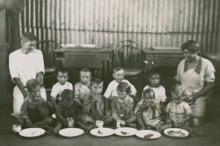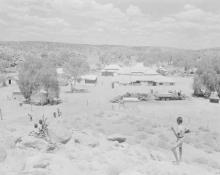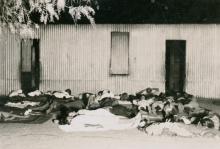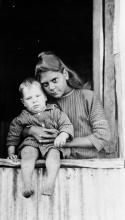Alice Springs
The Bungalow was established at a time when it was official government practice to remove Aboriginal and Torres Strait Islander children who were labelled 'half-caste'. These children were removed from their families and communities under the belief that they were good canditates for assimilation into broader white society . At the Bungalow, removed children were first placed under the care of Topsy Smith, whose own children were labelled 'half caste' . Ida Standley, who was the Bungalow matron between 1916 to 1929, was committed to permanently keeping Aboriginal and Torres Strait Islander children away from their families: 'what it takes us five years to build up is undone by the black influence in 5 minutes'. Conditions were described as 'a scandal' and 'a place of squalid horror' from 1924 witnesses' reports. At that time, the Bungalow lacked running water and had only a single toilet with no bathroom . The Bungalow has been described as a 'temporary staging area' where children were temporarily housed before being sent interstate; children who were housed at Garden Point on Croker Island or the Retta Dixon Home in Darwin had a good chance of staying within the Northen Territory, but children at the Bungalow were often sent far away from their families and communities .
0Established in 1914, closed in 1942.
The BungalowHuman Rights and Equal Opportunity Commission. Bringing Them Home: Report of the National Inquiry into the Separation of Aboriginal Children from their Families (Human Rights and Equal Opportunity Commission, 1997) 116
Tony Austin, I Can Picture the Old Home So Clearly: The Commonwealth and ÔHalf-casteÕ Youth in the Northern Territory 1911-1939 (Aboriginal Studies Press, 1993) 63
Karen George and Gary George, The Bungalow (1914 - 1942) (16 December 2014) Find & Connect https://www.findandconnect.gov.au/ref/nt/biogs/YE00019b.htm
John Williams-Mozley, 'The Stolen Generations: What Does This Mean for Aboriginal and Torres Strait Islander Children and Young People Today?' in Kaye Price (ed), Aboriginal and Torres Strait Islander Education: An Introduction for the Teaching Profession (Cambridge University Press, 2012) vol 1, 21, 23-24.
NTKatie Stride and Leilehua Helu, No Native Title Over Brisbane CBD and Surrounding Areas (21 August 2015) Queensland Government
http://www.crownlaw.qld.gov.au/resources/publications/no-native-title-over-brisbane-cbd-and-surroun…
I've come to realise that because of Dad being taken away, grief and all that's been carried down to us. We're not organised. We don't know where we're heading.
Confidential evidence 403, Queensland: speaker's father was removed at the age of 18 months to The Bungalow, Northern Territory.
Human Rights and Equal Opportunity Commission, Bringing them Home: National Inquiry into the Separation of Aboriginal and Torres Strait islander Children from Their Families (1997)
18 months Confidential evidence 403I remember this woman saying to me, 'Your mother's dead, you've got no mother now. That's why you're here with us'. Then about two years after that my mother and my mother's sister all came to The Bungalow but they weren't allowed to visit us because they were black. They had to sneak around onto the hills. Each mother was picking out which they think was their children. And this other girl said, 'Your mother up there'. And because they told me that she was dead, I said, 'No, that's not my mother. I haven't got a black mother' (p. 134).
I found the Methodist Mission [Croker Island] very helpful and myself, from my experience, I really can't condemn the United Church, or Methodist Mission. Because they've been excellent to us. There were one hundred children and they showed a little bit of affection to each of us, y'know. They didn't show any favouritism (p. 354).
Confidential evidence 544, Northern Territory: woman removed to The Bungalow at 5 years in the 1930s; after seven years transferred to Croker Island Mission.
Human Rights and Equal Opportunity Commission, Bringing them Home: National Inquiry into the Separation of Aboriginal and Torres Strait islander Children from Their Families (1997)
5 years Confidential evidence 544When anybody come to pick up a worker they used to line us up and they'd make you flex your muscles. If you were big and strong they'd pick you - like a slave market. I was sent out at 11. I worked there for seven and a half years, never got paid anything, all that time. We used to bring the cattle in ... we didn't get nothing. So I had to join the army to survive (p. 99).
There's where food was scarce again. Hardly anything ... night time we used to cry with hunger, y'know, lice, no food. And we used to go out there to the town dump ... we had to come and scrounge at the dump, y'know, eating old bread and smashing tomato sauce bottles and licking them. Half of the time our food we got from the rubbish dump. Always hungry there. That's another thing - culture was really lost there, too. Because religion was drummed into us, y'know, when we'd be out there and we'd have knuckle-up and that, we were that religious we'd kneel down in prayer ... We had to pray every time you swear or anything, you'd go down on your hands and knees ... they pumped that religion into us (p. 117).
There was no food, nothing. We was all huddled up in a room ... like a little puppy-dog ... on the floor ... Sometimes at night time we'd cry with hunger, no food ... (p. 138).
I was sent out when I was eleven years old to [pastoral station]. I worked there for seven and a half years. Never got paid anything all that time. [Even] Aboriginal people I was working with used to get 30 bob. Yet we didn't get nothing. I used to say, 'Where's my money?' 'Oh, they put it into the trust account.' So I worked there for them. Oh rough, hardly any food or anything, put out in remote area on me own, drawing water and that, looking after cattle ... no holiday, no pay. I never received one pay that seven and a half years I was there (p. 150).
Confidential evidence 549, Northern Territory: man removed to Kahlin Compound at 3 years in the 1920s or 1930s; subsequently placed at Pine Creek and The Bungalow.
Human Rights and Equal Opportunity Commission, Bringing them Home: National Inquiry into the Separation of Aboriginal and Torres Strait islander Children from Their Families (1997)
3 years Confidential evidence 549My grandmother was taken from up Tennant Creek. What gave them the right to just go and take them? They brought her down to The Bungalow [at Alice Springs]. Then she had Uncle Billy and my Mum to an Aboriginal Protection Officer. She had no say in that from what I can gather. And then from there they sent her out to Hermannsburg - because you know, she was only 14 when she had Uncle Billy, 15 when she had Mum. When she was 15 and a half they took her to Hermannsburg and married her up to an Aranda man. That's a no-no. And then from there, when Mum was 3, they ended up taking Mum from Hermannsburg, putting her in The Bungalow until she was 11.
And then they sent her to Mulgoa mission in New South Wales. From there they sent her to Carlingford Girls' Home to be a maid. She couldn't get back to the Territory and she'd had a little baby.
Agnes [witness's sister] and I have met him [their older brother]. We met him when he was 35. He's now 42 so that's not that far away. Mum had him and she was working but she doesn't know what happened to her money. When she kept asking for her money so she could pay her fare back to Alice Springs they wouldn't give her any.
I've got paperwork on her from Archives in New South Wales. There's letters - stacks of 'em - between the Aboriginal Protection Board, New South Wales, and Northern Territory. All on my mother. They were fighting about which jurisdiction she was in - New South Wales yet she was a kid from the Northern Territory. So one State was saying we're not paying because she's New South Wales, they should pay.
In the end New South Wales said to Mum, 'I'll pay your fare back on the condition that because you haven't got a husband and you've got a baby, you leave that baby here'. So she left her baby behind and came back to the Territory.
And then she had me and then my brother and another two brothers and a sister and we were all taken away as soon as we were born. Two of them were put in Retta Dixon and by the time they were 18 months old they were sent down south and adopted. She had two kids, like they were 15 months apart, but as soon as they turned 18 months old they were sent down south and adopted out.
One of them came back in 1992. He just has that many problems. The others we don't know where they are. So it's like we've still got a broken family.
I was taken away in 1950 when I was 6 hours old from hospital and put into Retta Dixon until I was 2 months old and then sent to Garden Point. I lived in Garden Point until 1964. And from Garden Point, Tennant Creek, Hermannsburg. While in Garden Point I always say that some of it was the happiest time of my life; others it was the saddest time of my life. The happiest time was, 'Yippee! all these other kids there'. You know, you got to play with them every day. The saddest times were the abuse. Not only the physical abuse, the sexual abuse by the priests over there. And they were the saddest because if you were to tell anyone, well, the priests threatened that they would actually come and get you.
Everyone could see what they were doing but were told to keep quiet. And just every day you used to get hidings with the stock-whip. Doesn't matter what you did wrong, you'd get a hiding with the stockwhip. If you didn't want to go to church, well you got slapped about the head. We had to go to church three times a day. I was actually relieved to leave the Island.
In 1977 I had three children. In 1977 my oldest was three years old then. I had another one that was twelve months and another one that was two months old. All those kids were taken off me. The reason behind that was, well, I'd asked my girl-friend and so-called sister-in-law if she could look after my kids. She wouldn't look after my daughter because my daughter's black. So, she said she'd take the two boys and that was fine. And while I was in hospital for three months - that's the only reason I asked them to take 'em 'cause I was going to hospital because I had septicaemia.
I couldn't get my kids back when I came out of hospital. And I fought the welfare system for ten years and still couldn't get 'em. I gave up after ten years. Once I gave up I found out that while I was in hospital, my sister-in-law wanted to go overseas with my two boys 'cause her husband was being posted there for 12 months from foreign affairs. And I know she brought some papers in for me to sign while I was in hospital and she said they were just papers for their passports. Stupid me, being sick and what-have-you didn't ask questions - I signed 'em and found out too late they were adoption papers. I had 30 days to revoke any orders that I'd signed.
And with my daughter, well she came back in '88 but things just aren't working out there. She blames me for everything that went wrong. She's got this hate about her - doesn't want to know. The two boys know where I am but turned around and said to us, 'You're not our mother - we know who our real mother is'.
So every day of your bloody life you just get hurt all the time ... (p. 127-129)
Confidential evidence 557, Northern Territory
Human Rights and Equal Opportunity Commission, Bringing them Home: National Inquiry into the Separation of Aboriginal and Torres Strait islander Children from Their Families (1997)
Birth Confidential evidence 557 - Evie... there was an air of gloom and repression about the place and the children were sad, silent and sullen. There was no laughter and it was a slow process to gain the confidence of the children ... The children and their mothers were frightened to say anything and had not the wherewithal to cope with the problems. Eventually one of the older girls plucked up enough courage to smuggle out a letter of complaint which came to the notice of the authorities ... On receipt of the letter the superintendent was immediately dismissed and left Alice Springs overnight. Girls of all ages from babies to adolescents slept in one dormitory that was poorly ventilated. There were rows of three tiered beds. Such cramped conditions led to all sorts of emotional and developmental pressures on those subject to them. The boys slept in a separate dormitory under similar circumstances. The advent of a new superintendent changed things markedly. The general situation improved ... [but] the children took a long time to recover from the repressive treatment
120
NA Evidence 7 - Mrs Isabelle & Mr John SmithHarold Thomas (Bundoo) is an artist best known for designing the Aboriginal flag.
Harold was born in Alice Springs. At the age of seven, he was taken from his family and sent to St Frances House, near Adelaide. At the age of seventeen, he was awarded a scholarsharhip to study at the South Australia School of Art. Harold was the first Aboriginal person to graduate from an Australian art school. Harold designed the now iconic Aboriginal flag in 1970, while he was working at he South Australian Museum: "In my university days there was a question of identity among Aboriginal people. People stood up during marches for civil rights to express their Aboriginal identity. The flag stood for all of that. The colours reflect an awakening of their emerging political conscience."
Harold is well-known for his watercolour, oil and acrylic paintings, which reflect his "deep love for the country, its people, wildlife and history" and have been disaplayed in exhibitions across the country. In 2016, his painting 'Tribal Abduction,' which depicts the forcible removal of a child from their mother, won the Telstra National Aboriginal and Torres Strait Islander Art Award, Australia's most prestigious Indigenous art prize. His painting 'Myall Creek Massacre' was shortlisted for the same award in 2017.
Harold Thomas (Bundoo)
The Bungalow, 1928-29: The person on the right is a parent to two of the children shown

The Bungalow, 1951

The Bungalow, 1928-29: A group of people, ranging from 1 to 25 years old, sleeping outside on sheets.

The Bungalow, 1923
